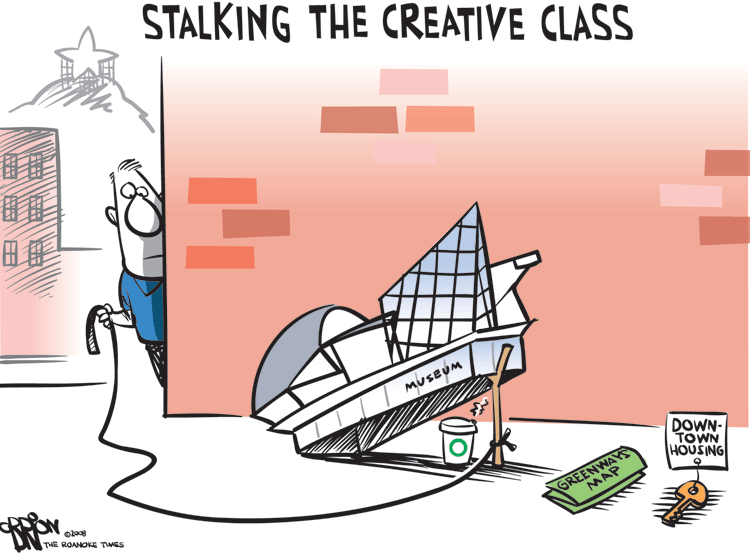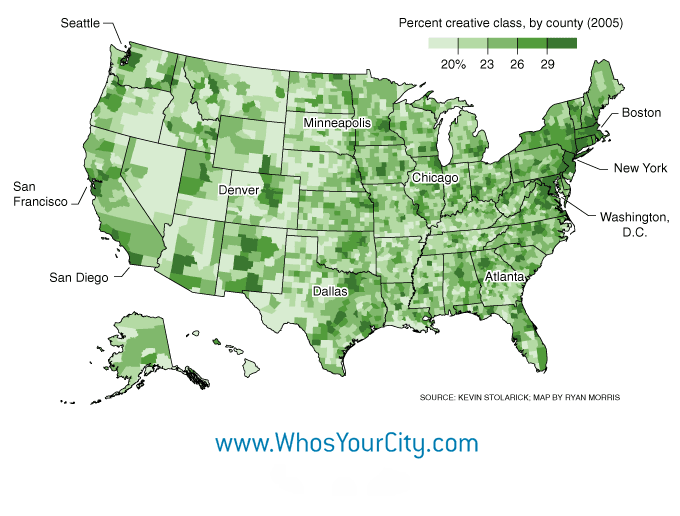Place and community are still critical factors for growth and development. The Internet and modern technology hasn’t destroyed geography. That is “the greatest of all modern myths about cities,” says Florida from Carnegie Mellon University, researcher and author of The Rise of the Creative Class. His book focuses on diversity and creativity as basic drivers of innovative and regional and national growth. “Place and community are more critical factors than ever before” (Florida 4).

In order for a region to prosper, to grow and develop however, cities need to attract intellectuals and creative types. They are the key. “The human capital theory establishes that creative people are the driving force in regional economic growth. From that perspective, economic growth will occur in places that have highly educated people” (Florida 7).
Intellectuals and creative types offer much to a region. American sociologist C. Wright Mills is a fiercely independent intellectual with an impassioned social vision and a remarkable capacity for community. His ideas are straight forward and compelling. He says:
The independent artist and intellectual are among the few remaining personalities equipped to resist and to fight the stereotyping and consequent death of genuinely living things. Fresh perception now involves the capacity to continually unmask and to smash the stereotypes of vision and intellect with which modern communications [i.e. modern systems of representation] swamp us. These worlds of mass-art and mass-thought are increasingly geared to the demands of politics. That is why it is in politics that intellectual solidarity and effort must be centered. If the thinker does not relate himself to the value of truth in political struggle, he cannot responsibly cope with the whole of live experience. -C. Wright Mills

Who are the intellectuals and creative types? “Antonio Gramsci, the Italian Marxist, activist, journalist and brilliant political philosopher who was imprisoned by Mussolini between 1926 and 1937, wrote in his Prison Notebook that all men are intellectuals, one could therefore say: but not all men have in society the function of intellectuals” (Gramsci 9). “Those who perform the intellectual function in society” says of Gramsci in his book, “Representatives of the Intellectual, “can be divided into two types: first, traditional intellectuals such as teachers, priest, and administrators, and second, organic intellectuals, who Gramsci saw as directly connected to classes or enterprises that used intellectuals to organize interest, gain more power, get more control” (Said 4). They are the “Conscience of mankind” and whose “purpose” is to “advance human freedom and knowledge” (17). Intellectuals and creative types “engage in work whose function is to “create meaningful new forms, such as “scientists and engineers, university professors, poets and novelists, artists, entertainers, actors, designers, architects, nonfiction writers, editors, cultural figures, think-tank researchers, analysts, and other opinion-makers” (Florida 8). They also include “reactive professionals” such as “knowledge-based occupations in high-tech sectors, financial services, the legal and health-care professions, and business management” (8) in America, which is “roughly 30% of the entire U.S. workforce in—up just 10% at the turn of the 20th century and less than 20% as recently as 1980” (8).

Companies need creative and intelligent people, as well as regions and cities in order to do well. So, what draws them? What draws creative and intelligent people to an area? Florida’s study revealed they want to live in “creative centers.” These creative centers tend to have “high concentrations of creative economic outcomes, in the form of innovations and high-tech industry growth, strong signs of overall regional vitality, such as increases in regional employment and population.” These people want to live where the creative centers are, where there is culture, art, technology, “high-quality experiences, openness to diversity (tolerance) of all kinds, and the opportunity to validate their identities as creative people” (9).

In addition, Florida’s study revealed high-tech areas are not the same as thriving creative centered areas. For one thing, high-tech areas are not growing and thriving. They score “below average on almost every measure of social capital.” They have “less trust, less reliance on faith-based institutions, fewer clubs, less volunteering, less interest in traditional politics, and less civic leadership” (14).
Although place and community are still critical factors for growth and development, a preference for “weak ties and quasi-anonymity” (Florida 16) has emerged. There is a great migration of the intelligent and creative types to specific regions in America. As a result, an inequality is rising and settling in only about a dozen places (17).
Who’s Your City?

Sources
Florida , Richard. “Cities and the Creative Class.” City & Community (Wiley-Blackwell) 2:1 (2003): 3-19. Print.
Said W., Edward. Representations of the Intellectual. New York, 1994, 1996. Print.